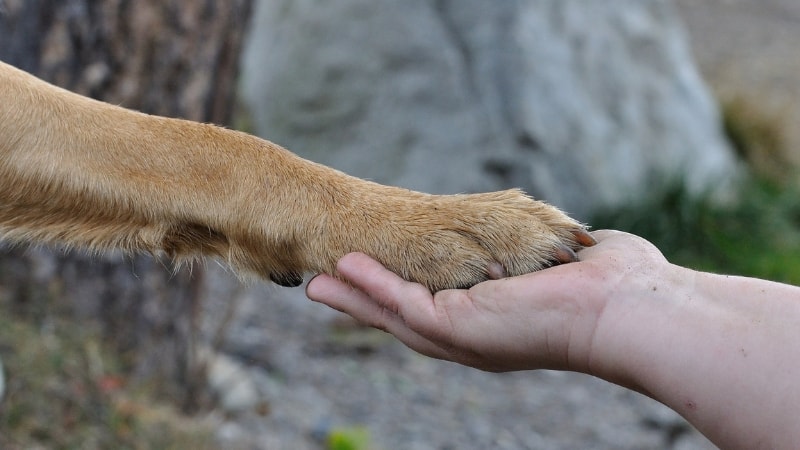When your dog is talking, do you listen? Are you paying attention? Most dog owners forget that the easiest way to bond with their pet, not to mention when also training the dog, is to understand basic dog body language.

Barking is not the topic here, but rather, the way our dogs communicate to us and the world around them with the use of their dog body language. Let’s start with the tail.
Dog Tail Communication
There are lots of different wags. Plain, ordinary, enthusiastic wagging means “I’m a friendly fella!” A slow wag is the nervous laugh of a dog who is embarrassed about something. A tail held high and wagged widely, instead of only slightly, means he wants to play. If he wiggles up to you after you have disciplined him, wagging his tail between his hind legs, he is saying he wants to make up and is sorry.
Why Does A Dog Nose Around?
Most of a dog’s nosing around is done for identification purposes. When he approaches another dog, the first thing he does is sniff him out to discover whether he is friend or foe. First he smells the rear; then he smells the face.
Why Does Your Dog Prop His Paw On Your Chest?
When your dog props his paws on your chest or shoulders, he is trying to get in position to smell your breath. He can tell whether it’s you for sure, and what you’ve been eating that he might get some of!
What Can You Tell From Your Dog’s Lips
You can often tell immediately whether a dog cares for your company by noticing the position of his lips. When he draws the corners of his lips forward, he is feeling distinctly antisocial. He may become aggressive and could attack, especially if he has drawn his lips open to show his teeth. However, when he pulls back horizontally so that he appears to be grinning, he is expressing his friendliness or submissiveness.
When he feels very submissive, he will smile like a simpleton. He looks like he’s feeling silly and has lots of “waggle”. A few dogs are capable of the mimic grin, something they have learned from humans and display only to humans. They retract their lips to show their front teeth in a wide toothpaste smile.
Why Does Your Dog Chew Up Things In The House
A dog that uses those teeth to chew up your slippers may be telling you that he is unhappy. A chewing dog is a fretting dog. A pet that gets a lot of attention otherwise, but is left shut in the house alone all day will fret in this manner. When he is lonely and unhappy, and he wants something done – now – then he becomes like a hyperactive child. He’s liable to chew up everything in the house eventually.
What About The Tongue?
Let’s talk about a dog’s tongue. He uses it primarily for getting food and water, and for cooling himself. When it comes to dog body language, he licks you with it to show his friendliness and to ask for attention. A dog that licks walls and eats dirt or dust, however, and does so without the need of a supplement in his diet, is desperate for attention or company.
His tongue can also tell you when he has swallowed his pill after being given a vitamin or medication. When it has gone down, his tongue will pop out like a frog’s, two times in quick succession.
Dog Body Language – Eyes
Now let’s discuss how a dog uses his eyes to “talk”. How a dog moves his eyes can tell you much about his mood. A dog who is being submissive avoids eye contact with a dominant dog. One that is trying to make up with his master looks away from him in an exaggerated way. A contented dog curled up in a corner has a sleepy-eyed look.
On the other hand, a direct stare from a dog, especially the dog growls with eye contact, says he feels aggressive. This means you have to keep your distance. When veterinarians are working with dogs in their medical rooms, they should be watching the eyes more than anything else to determine which dog might snap at him.
A good rule to follow for safety is this: A dog that watches every move you make is probably about to bite you!

Dog Body Language – Ears
Dogs speak with their ears as well as listen with them. A dog holding his ears straight up, forward, and erect, is alert. He may be checking on something he heard. He may be considering the possibility of a serious scuffle with an enemy or some friendly romping with his master.
Lowered, relaxed ears are signs of a relaxed dog. He is calm and sociable. If he is showing submissiveness or is frightened, he’ll keep them very low. A dog making a threat (and on the verge of attacking) twists his ears outward and downward, laying them flat against his head.
Dog Noises And What They Mean?
A dog’s vocal repertoire of whines, howls, growls, and barks are part of dog body language. Noises are what he resorts to when he considers it imperative that someone get his message.
A dog that goes “Yip. Yip. Yip… yip, yip… yip!” for hours on end is usually bored. Likely he has been confined and left alone.
Sometimes he will vary his “yips” with a frustrated-sounding “Arrrrr, rarr, arrarrrr.”
A wailing puppy begging for attention delivers a high-pitched “Mmm, mmm, mmmmm,” usually in the dead of night.

